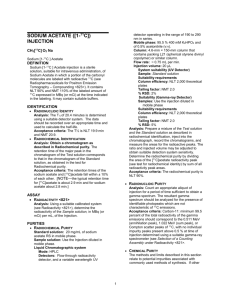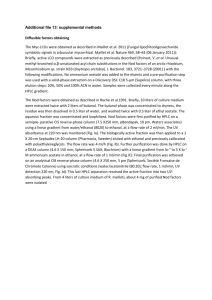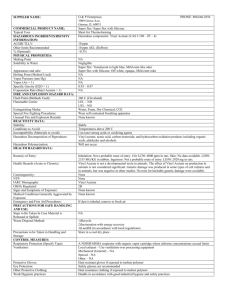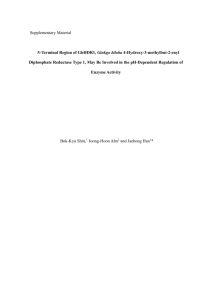Supplemental Digital Content
advertisement
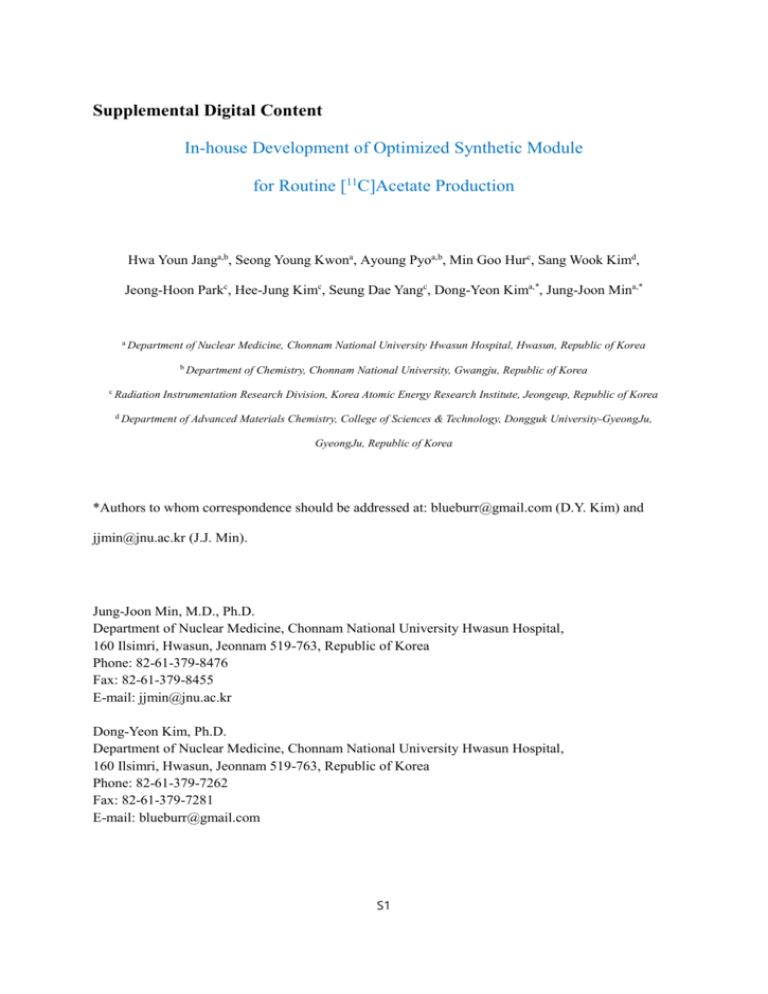
Supplemental Digital Content In-house Development of Optimized Synthetic Module for Routine [11C]Acetate Production Hwa Youn Janga,b, Seong Young Kwona, Ayoung Pyoa,b, Min Goo Hurc, Sang Wook Kimd, Jeong-Hoon Parkc, Hee-Jung Kimc, Seung Dae Yangc, Dong-Yeon Kima,*, Jung-Joon Mina,* a Department of Nuclear Medicine, Chonnam National University Hwasun Hospital, Hwasun, Republic of Korea b Department c Radiation of Chemistry, Chonnam National University, Gwangju, Republic of Korea Instrumentation Research Division, Korea Atomic Energy Research Institute, Jeongeup, Republic of Korea d Department of Advanced Materials Chemistry, College of Sciences & Technology, Dongguk University-GyeongJu, GyeongJu, Republic of Korea *Authors to whom correspondence should be addressed at: blueburr@gmail.com (D.Y. Kim) and jjmin@jnu.ac.kr (J.J. Min). Jung-Joon Min, M.D., Ph.D. Department of Nuclear Medicine, Chonnam National University Hwasun Hospital, 160 Ilsimri, Hwasun, Jeonnam 519-763, Republic of Korea Phone: 82-61-379-8476 Fax: 82-61-379-8455 E-mail: jjmin@jnu.ac.kr Dong-Yeon Kim, Ph.D. Department of Nuclear Medicine, Chonnam National University Hwasun Hospital, 160 Ilsimri, Hwasun, Jeonnam 519-763, Republic of Korea Phone: 82-61-379-7262 Fax: 82-61-379-7281 E-mail: blueburr@gmail.com S1 Table of Contents Information Page General S3 Automatic synthesis module S3 Production of [11C]CO2 S4 Quality control S4 PET-CT study of [11C]acetate and [18F]FDG S5 Radio TLC chromatogram of [11C]acetate S6 Analytical HPLC chromatogram of acetate S7 Analytical HPLC chromatogram of [11C]acetate S7 GC chromatogram of [11C]acetate S8 Reference S9 S2 General All commercial reagents and solvents were: purchased from Sigma-Aldrich; of analytical grade; and used without further purification. The Chromfix® PS cartridges PS-AG+ (240 mg, strong cation exchanger, Ag+ form), PS-H+ (230 mg, strong cation exchanger, H+ form) and PS-OH- (200 mg, strong anion exchanger, OH- form) were obtained from Macherey-Nagel (Germany). The MaxiCleanTM SAX cartridge (600 mg, strong anion exchanger, acetate form) was purchased from Grace (USA). Quality control was achieved by radio thin layer chromatography (TLC) and HPLC. TLC was performed on Merck silica gel 60 F254 glass plates and the HPLC set-up was equipped with a SP930D pump, UV730D UV detector (Young-Lin Inc., Korea), and FC-3200 high energy gamma detector (Bioscan, USA) to measure the radioactive flow. The UV detection wavelength was 220 nm for all experiments. The analytical (CarboPac® PA1, 4.0 mm × 250 mm) HPLC columns were purchased from Dionex. Residual solvent was assessed by gas chromatography. The capillary column (DBWAXetr, 30 m × 0.25 mm × 0.25 µm) was purchased from Agilent Technologies. The endotoxin test was performed using an Endosafe®-PTSTM (Charles River Laboratories, USA) and FTM (Hanil Komed, Korea) was employed for the sterility test. A CRC-712MH radioisotope calibrator (Capintec Instruments, USA) served for radioactivity measurements. [11C]CO2 was produced on a PETtrace cyclotron (16.4 MeV, General Electric Company, USA) by irradiation of a N2 + 0.5% O2 mixture gas target. Automatic synthesis module The main body of the module was anodized to prevent oxidation during reaction and the passage of reagents through it. Solenoid 2,3-way valves (Bürkert; 0127 Analytical Valve) and polytetrafluoroethylene and PEEK tubings (1.59 mm) were used to convey radioactive materials in the synthesis module. The flow of [11C]CO2 and nitrogen was regulated and monitored with a flow meter. A P2O5 column was used between the target and reaction vessel to prevent inflow of moisture. Solutions and radioactive agents were transferred using sterile syringes and a vacuum pump S3 controlled with the use of Lab–View (National Instrument). Production of [11C]CO2 [11C]CO2 was produced using a PETtrace cyclotron equipped with a tungsten target from a mixture of nitrogen and oxygen target gas by the 14N(p,α)11C nuclear reaction. The beam current was 20 µA and the irradiation time was 10 min. After production, [11C]CO2 was delivered to a stainlesssteel loop trap immersed in a liquid nitrogen bath. Quality control Identity, as well as chemical and radiochemical purity were determined by radio TLC and HPLC. Radio TLC was performed by the modification of a previously reported method [1]. A basic TLC silica plate was prepared by immersing the plate in a saturated sodium hydroxide solution in methanol and allowing it to dry at room temperature. Sodium hydroxide was added to the [11C]acetate solution before spotting onto the basic TLC plates. The plates were developed with methanol (retention factor, Rf: [11C]acetate: 0.6–0.7; [11C]carbonate: 0.0). HPLC was also performed to check chemical and radiochemical purity (CarboPak® PA1 column, mobile phase: 0.1 mol/L sodium hydroxide, flow rate: 1.0 mL/min, 220 nm; retention time, tR: 2.82 min). Residual solvent was assessed using a gas chromatograph equipped with a flame ionization detector (FID). The capillary column and FID were used under the following conditions: column temperature, 250 °C; oven temperature, 70 °C; FID temperature, 250 °C. THF was apparent after 2.92 min. To obain a result rapidly, an endotoxin test was performed using a portable detector system, because of the short-half life and routine use of [11C]acetate [2-5]. A volume of 25 µL of [11C]acetate solution was dispensed into the test cartridge. This cartridge was inserted into the portable detector and in less than 15 min gave an endotoxin value of <1.0 EU/mL (0.2 ng = 1.0 EU). An FTM was used for the sterility test. [11C]Acetate solution (100 µL) was added to the FTM and incubated at 37 °C for 15 days. The pH was measured by the standard pH meter. S4 PET-CT study of [11C]acetate and [18F]FDG PET-CT images using [11C]acetate were acquired 15 min after the administration of 555 MBq (15 mCi) of [11C]acetate. Additionally, PET-CT images using [18F]FDG were acquired 60 min after the administration of 370 MBq (10 mCi) of [18F]FDG. Two nuclear physicians evaluated the biodistribution and image quality of [11C]acetate in patient. Next they compared the diagnostic accuracy of [11C]acetate PET-CT with that of [18F]FDG PET-CT in patients with HCC. Maximum standardized uptake values (SUVmax) were also measured in those lesions for semiquantitative analysis. S5 Radio TLC chromatogram of [11C]acetate A basic TLC silica plate was prepared by immersing the plate in a saturated sodium hydroxide solution in methanol and allowing it to dry at room temperature. Sodium hydroxide was added to the [11C]acetate solution before spotting onto the basic TLC plates. The plates were developed with methanol from 50 mm to 150 mm (retention factor, Rf: [11C]acetate: 0.6–0.7; [11C]carbonate: 0.0). S6 Analytical HPLC chromatogram of acetate and [11C]acetate HPLC was also performed to check chemical and radiochemical purity (CarboPak® PA1 column, mobile phase: 0.1 mol/L sodium hydroxide, flow rate: 1.0 mL/min, 220 nm; retention time, tR: 2.82 min, A: UV detector, B: high energy gamma detector). S7 GC chromatogram of [11C]acetate Residual solvent was assessed using a gas chromatograph equipped with a flame ionization detector (FID). The capillary column and FID were used under the following conditions: column temperature, 250 °C; oven temperature, 70 °C; FID temperature, 250 °C. THF was apparent after 2.92 min. S8 References 1. Berridge MS, Cassidy EH, Miraldif F. [11C]Aeetate and [11C]methionine: improved syntheses and quality control. Appl Radiat lsot 1995; 46:173-175. 2. Gee AP, Sumstad D, Stanson J, Watson P, Proctor J, Kadidlo D, et al. A multicenter comparison study between the Endosafe PTS rapid-release testing system and traditional methods for detecting endotoxin in cell-therapy products. Cytotherapy 2008; 10:427-435. 3. Hollyman D, Stefanski J, Przybylowski M, Bartido S, Borquez-Ojeda O, Taylor C, et al. Manufacturing validation of biologically functional T cells targeted to CD19 antigen for autologous adoptive cell therapy. J Immunother 2009; 32:169-180. 4. Petsch D, Anspach FB, Endotoxin removal from protein solutions. J Biotechnol 2000; 76:97119. 5. Soncin S, Lo Cicero V, Astori G, Soldati G, Gola M, Surder D, et al. A practical approach for the validation of sterility, endotoxin and potency testing of bone marrow mononucleated cells used in cardiac regeneration in compliance with good manufacturing practice. J Transl Med 2009; 7:78. S9
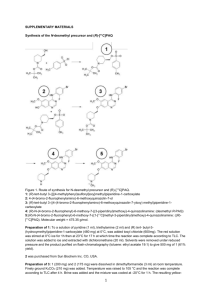
![ACCURACY OF [11C] CHOLINE POSITRON EMISSION](http://s3.studylib.net/store/data/006910188_1-178035aba028502f62a71ecfd059e7d4-300x300.png)
